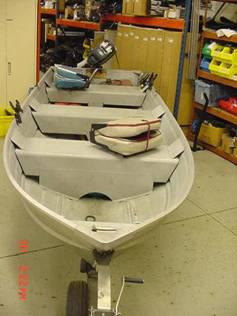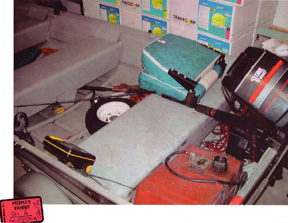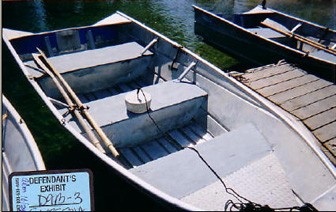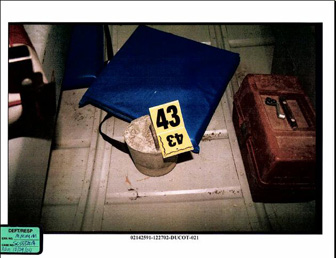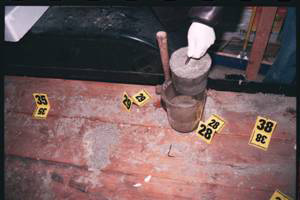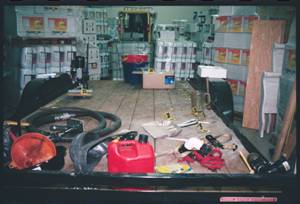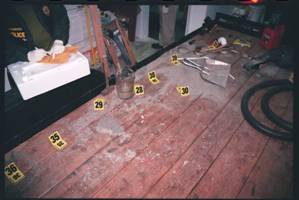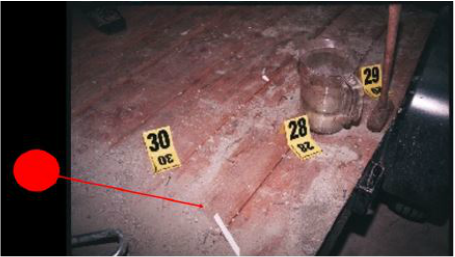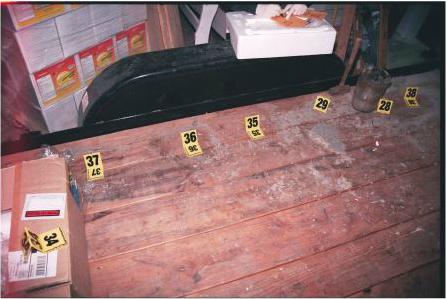Top Ten Facts you need to know about Scott's boat
This article focuses on the facts surrounding Scott Peterson’s boat. The prosecution asserted that Scott used it to dump the body of his pregnant wife, Laci, in the San Francisco Bay. They claimed his motive for killing Laci was a life of freedom represented by his infidelity with Amber Frey.
Scott Peterson met Amber Frey on November 20th, 2002. Much of what Scott said to Amber was a lie, including making her think he was not married. 16 days after they met, on Friday, December 6th, 2002, Amber’s best friend Shawn Sibley was told by some colleagues that Scott was married. Shawn called Scott and confronted him about whether or not he was married. He had been caught. Scott initially told Shawn he was not married. He called her back about an hour later and told her he had been married but that he had lost his wife. Shawn gave Scott until Monday to tell Amber this information.
The prosecution alleged that once Scott was confronted by Shawn Sibley on December 6th, he hatched a plan to murder Laci and Conner for someone he had met 16 days before. He was going to buy a ‘secret’ boat, then kill his wife and unborn son, weigh down her body with homemade anchors and then dump her in the San Francisco Bay where he had ‘researched’ charts.
Following is a list of 10 facts that refute the elements of the prosecution’s theory.
1. Scott had previously owned boats and had conversations about purchasing another boat before he met Amber.
It was not unusual for Scott to own a boat. Defense attorney, Mark Geragos said in his opening statement that this “was the fourth boat that he (Scott) had owned. He has bought and sold boats his entire adult life.” Scott’s dad, Lee, testified they had also owned boats Scott’s entire childhood. Within one month of dating, Scott and Laci had already gone on a fishing date and a sailing date.
Three of Scott’s friends told police that they had conversations with Scott about purchasing a boat:
Scott Peterson met Amber Frey on November 20th, 2002. Much of what Scott said to Amber was a lie, including making her think he was not married. 16 days after they met, on Friday, December 6th, 2002, Amber’s best friend Shawn Sibley was told by some colleagues that Scott was married. Shawn called Scott and confronted him about whether or not he was married. He had been caught. Scott initially told Shawn he was not married. He called her back about an hour later and told her he had been married but that he had lost his wife. Shawn gave Scott until Monday to tell Amber this information.
The prosecution alleged that once Scott was confronted by Shawn Sibley on December 6th, he hatched a plan to murder Laci and Conner for someone he had met 16 days before. He was going to buy a ‘secret’ boat, then kill his wife and unborn son, weigh down her body with homemade anchors and then dump her in the San Francisco Bay where he had ‘researched’ charts.
Following is a list of 10 facts that refute the elements of the prosecution’s theory.
1. Scott had previously owned boats and had conversations about purchasing another boat before he met Amber.
It was not unusual for Scott to own a boat. Defense attorney, Mark Geragos said in his opening statement that this “was the fourth boat that he (Scott) had owned. He has bought and sold boats his entire adult life.” Scott’s dad, Lee, testified they had also owned boats Scott’s entire childhood. Within one month of dating, Scott and Laci had already gone on a fishing date and a sailing date.
Three of Scott’s friends told police that they had conversations with Scott about purchasing a boat:
- Guy Miligi told police on January 4, 2003 that he and Scott had discussed purchasing a ski boat together prior to December, but once Scott joined the Del Rio Country Club on December 1st, 2002, he told Guy he’d be unable to buy the speedboat.
- Jodi Miligi told police on January 4, 2003 that she remembered Scott discussing a boat one to three weeks prior to Thanksgiving.
- Brian Ulrich told detectives on January 4, 2003 that Scott had been discussing buying a boat for over three months.
2. Scott did not "research" tidal information on the internet.
Detective Wall testified that Scott used his home computer to search for boating regulations, Department of Fish and Game Rules and Regulations, to search classified ads for boats and for information on fishing. In all Scott’s computer use, there is only about 30 seconds total of material that contained any kind of charts for the San Francisco Bay. The prosecution and many news reports egregiously referred to these 30 seconds as “researching” the currents in the San Francisco Bay.
Prosecution Exhibits 179 a-u and 182 a-ee show all pages of Scott’s internet searches.
Detective Wall testified that Scott used his home computer to search for boating regulations, Department of Fish and Game Rules and Regulations, to search classified ads for boats and for information on fishing. In all Scott’s computer use, there is only about 30 seconds total of material that contained any kind of charts for the San Francisco Bay. The prosecution and many news reports egregiously referred to these 30 seconds as “researching” the currents in the San Francisco Bay.
Prosecution Exhibits 179 a-u and 182 a-ee show all pages of Scott’s internet searches.
3. Scott's search for a boat is clearly motivated by an intent to go fishing, not dump a body.
The prosecution implied in their opening statement and in the questioning of witnesses that Scott’s boat was inappropriate and not equipped for fishing.
On Saturday, December 7th at 4:41pm, Scott logged onto ModBee.com (the web-site for the Modesto newspaper) and searched the classifieds for boats. This computer search was submitted as exhibits 178A-E.
The prosecution implied in their opening statement and in the questioning of witnesses that Scott’s boat was inappropriate and not equipped for fishing.
On Saturday, December 7th at 4:41pm, Scott logged onto ModBee.com (the web-site for the Modesto newspaper) and searched the classifieds for boats. This computer search was submitted as exhibits 178A-E.
Scott looked at three boats and ended up purchasing the third boat listed from a Bruce Peterson (no relation). In addition to the 15 horsepower motor, the 14’ game fisher was equipped with fishing gear that included two fishing chairs, two rod holders, a trolling motor and a fish finder.
Bruce Peterson testified that he used the boat for fishing, and the prosecution’s expert fishing witness, Angelo Cuanang, also testified that the boat was equipped for fishing. On Sunday, December 8th, Scott made arrangements to purchase the fishing boat and returned on Monday morning to pay for the boat. As you can see from the ads, Scott could have had the same size boat for less money or a bigger boat for less money. If his intent was to dump a body, a bigger boat would have been better, a cheaper boat would have been fine, and he certainly wouldn’t have needed a fish finder or fishing seats getting in the way.
He paid more money for a boat equipped for fishing because he was buying a fishing boat, not a body dumping boat.
Bruce Peterson testified that he used the boat for fishing, and the prosecution’s expert fishing witness, Angelo Cuanang, also testified that the boat was equipped for fishing. On Sunday, December 8th, Scott made arrangements to purchase the fishing boat and returned on Monday morning to pay for the boat. As you can see from the ads, Scott could have had the same size boat for less money or a bigger boat for less money. If his intent was to dump a body, a bigger boat would have been better, a cheaper boat would have been fine, and he certainly wouldn’t have needed a fish finder or fishing seats getting in the way.
He paid more money for a boat equipped for fishing because he was buying a fishing boat, not a body dumping boat.
4. Scott never had the boat in the water before December 24th, 2002.
Although Bruce showed Scott how the fish finder and motor worked, Bruce never started the motor. He also told Scott that he had not had the boat in the water since September, and had never used the boat in salt water. Scott had never taken the boat out prior to December 24th. He did not know for certain if the motor would work in salt water. That would be quite a risk to take if you had a body to dump. Not to mention how risky it would be to dump a body in broad daylight.
5. A fish finder indicates how deep the water is.
One thing a fish finder does is indicate how deep the water is. Scott told the police he was in the area around Brooks Island because it looked like a decent shallow area to fish in. One of the web pages Scott looked up suggested fishing for sturgeon in shallow areas 5-15 feet deep. The police allege that Scott dumped Laci’s body in an area that is as shallow as three feet during low tide. Why would someone dump a body in a shallow area when you have a fish finder on your boat that enables you to gauge the depth of the water?
6. Scott's boat was not stable enough to dump a body out of.
The police doubted that someone would be able to dump a body out of Scott’s boat. They theorized that Scott might have tied the boat to a buoy to stabilize it. They focused their searches underneath buoys and collected paint from a red buoy to see if it matched some red paint on the side of Scott’s boat. Nothing was found in their extensive searches and the paint did not match.
Also, Detective Hendee testified in court that he wanted to attempt a reenactment of a weighted body being dumped out of the boat, but neither the police nor prosecution ever tried. The link below is the unsuccessful reenactment attempted by Scott’s defense. The judge did not allow the jury to see it.
Although Bruce showed Scott how the fish finder and motor worked, Bruce never started the motor. He also told Scott that he had not had the boat in the water since September, and had never used the boat in salt water. Scott had never taken the boat out prior to December 24th. He did not know for certain if the motor would work in salt water. That would be quite a risk to take if you had a body to dump. Not to mention how risky it would be to dump a body in broad daylight.
5. A fish finder indicates how deep the water is.
One thing a fish finder does is indicate how deep the water is. Scott told the police he was in the area around Brooks Island because it looked like a decent shallow area to fish in. One of the web pages Scott looked up suggested fishing for sturgeon in shallow areas 5-15 feet deep. The police allege that Scott dumped Laci’s body in an area that is as shallow as three feet during low tide. Why would someone dump a body in a shallow area when you have a fish finder on your boat that enables you to gauge the depth of the water?
6. Scott's boat was not stable enough to dump a body out of.
The police doubted that someone would be able to dump a body out of Scott’s boat. They theorized that Scott might have tied the boat to a buoy to stabilize it. They focused their searches underneath buoys and collected paint from a red buoy to see if it matched some red paint on the side of Scott’s boat. Nothing was found in their extensive searches and the paint did not match.
Also, Detective Hendee testified in court that he wanted to attempt a reenactment of a weighted body being dumped out of the boat, but neither the police nor prosecution ever tried. The link below is the unsuccessful reenactment attempted by Scott’s defense. The judge did not allow the jury to see it.
Another unsuccessful attempt was made by trial watcher, Phil Devan. His weighed down dummy floated when it was pitched overboard. A third unsuccessful experiment was shown on Court TV. In that video the “Scott” lost his balance and fell into the water. Unfortunately, these two videos are no longer available to watch on the internet.
The manufacturer of the boat also testified about the stability testing on the boat. They begin the test, with some water in the boat and then evenly distribute 142 pounds evenly along the side of the boat. Under these circumstances in an indoor pool (no wind, no current) the back corner of the boat was over an inch under water (See exhibit D5D 5). An engineer from the boat manufacturer said the boat would be less stable with out the water in it. For Scott to dump a body out of this boat, there would have been close to 385 pounds at the edge of the boat; Scott weighed around 200 pounds, Laci weighed 153 pounds, and the 4 alleged ‘anchors’ weighed around 32 pounds. As shown by the video above, the increase in weight at the edge of the boat resulted in the back right end of the boat sinking.
7. The purchase of the boat was not a secret and Scott never tried to hide the fact he had a boat.
During the preliminary hearing and the trial, the prosecution continually emphasized that no one knew about the boat. In their closing argument the prosecution stated:
“Nobody knew about it (the boat). No one, all the friends, family, the Peterson family, Rochas, nobody knew the defendant had bought a boat. So you've got this secret purchase going on.”
When Scott purchased the boat from Bruce Peterson, he paid cash. Scott did not pay cash to hide the transaction; Scott paid cash because Bruce asked to be paid in cash. Scott withdrew the $1400 from his joint checking account with Laci. Also, Scott did not try to hide his identity from Bruce or the DMV. Scott gave accurate information to Bruce including his home address. This information was filed with the DMV on 12-9-02. Another boat Scott looked at on December 8th was not registered with the DMV, so Scott decided not to purchase it.
Additionally, Scott had told the police that Laci knew about the boat and that she had been to the warehouse on December 20, 2002. Detective Brocchini was told about an eye witness who confirmed seeing Laci at the warehouse (where the boat was stored). When he heard about this witness in August of 2003, he purposely left it out of his police report. While under oath during the trial, he admitted to excising the information from his police report and acknowledged that he did not think it had been reported by any other officer. This woman later confirmed that Laci was at the warehouse on December 20, 2002. This situation confirmed that Scott was once again being truthful. It was Detective Brocchini who had been deceptive.
There is no evidence that Scott tried to keep the boat a secret. Testimony showed that Scott and Laci routinely made purchases and decisions that extended family members were not aware of. It had only been fifteen days since they bought the boat, it would be expected that not many people would be aware of it.
Scott never lied to anyone about having a boat. He discussed buying a boat with his friends, he used his own name to purchase the boat, and took the money out of a joint account with his wife. He immediately told the police on Christmas Eve that he’d been fishing and took them to his warehouse to show them the boat.
So the prosecution’s statement that ‘nobody knew about’ the boat was not true and to call the boat a ‘secret purchase’ was inaccurate.
8. Scott made one concrete anchor for his boat.
Bruce Peterson told Scott he intended to buy another boat, so he wanted to keep his ten and fifteen pound anchors. Scott told police he made an eight pound anchor similar to those he’d seen in rental fishing boats. A rental boat is pictured on the left and the anchor Scott made is pictured on the right.
The manufacturer of the boat also testified about the stability testing on the boat. They begin the test, with some water in the boat and then evenly distribute 142 pounds evenly along the side of the boat. Under these circumstances in an indoor pool (no wind, no current) the back corner of the boat was over an inch under water (See exhibit D5D 5). An engineer from the boat manufacturer said the boat would be less stable with out the water in it. For Scott to dump a body out of this boat, there would have been close to 385 pounds at the edge of the boat; Scott weighed around 200 pounds, Laci weighed 153 pounds, and the 4 alleged ‘anchors’ weighed around 32 pounds. As shown by the video above, the increase in weight at the edge of the boat resulted in the back right end of the boat sinking.
7. The purchase of the boat was not a secret and Scott never tried to hide the fact he had a boat.
During the preliminary hearing and the trial, the prosecution continually emphasized that no one knew about the boat. In their closing argument the prosecution stated:
“Nobody knew about it (the boat). No one, all the friends, family, the Peterson family, Rochas, nobody knew the defendant had bought a boat. So you've got this secret purchase going on.”
When Scott purchased the boat from Bruce Peterson, he paid cash. Scott did not pay cash to hide the transaction; Scott paid cash because Bruce asked to be paid in cash. Scott withdrew the $1400 from his joint checking account with Laci. Also, Scott did not try to hide his identity from Bruce or the DMV. Scott gave accurate information to Bruce including his home address. This information was filed with the DMV on 12-9-02. Another boat Scott looked at on December 8th was not registered with the DMV, so Scott decided not to purchase it.
Additionally, Scott had told the police that Laci knew about the boat and that she had been to the warehouse on December 20, 2002. Detective Brocchini was told about an eye witness who confirmed seeing Laci at the warehouse (where the boat was stored). When he heard about this witness in August of 2003, he purposely left it out of his police report. While under oath during the trial, he admitted to excising the information from his police report and acknowledged that he did not think it had been reported by any other officer. This woman later confirmed that Laci was at the warehouse on December 20, 2002. This situation confirmed that Scott was once again being truthful. It was Detective Brocchini who had been deceptive.
There is no evidence that Scott tried to keep the boat a secret. Testimony showed that Scott and Laci routinely made purchases and decisions that extended family members were not aware of. It had only been fifteen days since they bought the boat, it would be expected that not many people would be aware of it.
Scott never lied to anyone about having a boat. He discussed buying a boat with his friends, he used his own name to purchase the boat, and took the money out of a joint account with his wife. He immediately told the police on Christmas Eve that he’d been fishing and took them to his warehouse to show them the boat.
So the prosecution’s statement that ‘nobody knew about’ the boat was not true and to call the boat a ‘secret purchase’ was inaccurate.
8. Scott made one concrete anchor for his boat.
Bruce Peterson told Scott he intended to buy another boat, so he wanted to keep his ten and fifteen pound anchors. Scott told police he made an eight pound anchor similar to those he’d seen in rental fishing boats. A rental boat is pictured on the left and the anchor Scott made is pictured on the right.
Scott told the police he used a painter’s bucket to form the anchor and inserted a rebar loop in the concrete to tie a rope to. Scott said after he made the anchor, he used the remaining concrete next to his driveway. Even though Scott had told the police what he made the anchor in, they theorized he made it in a pitcher found at the warehouse.
It’s not shown in these pictures, but the anchor has an indentation in the bottom from the bucket it was made in. The pitcher does not have an indentation. The anchor is smaller in circumference than the pitcher and the angle of the pitcher does not match the angle of the anchor. It took a concrete expert to tell the police that the above anchor did not come out of the pitcher pictured below. The police later found a painters bucket at Home Depot that the anchor fit into – exactly like Scott said. Loose concrete was also found next to their driveway, just like Scott said.
It’s not shown in these pictures, but the anchor has an indentation in the bottom from the bucket it was made in. The pitcher does not have an indentation. The anchor is smaller in circumference than the pitcher and the angle of the pitcher does not match the angle of the anchor. It took a concrete expert to tell the police that the above anchor did not come out of the pitcher pictured below. The police later found a painters bucket at Home Depot that the anchor fit into – exactly like Scott said. Loose concrete was also found next to their driveway, just like Scott said.
The prosecution said in their opening statement that, “there was no rope or no chain or nothing in the boat that can be used to attach to (the) anchor”. Contrary to that statement, Detective Brocchini testified that there was a rope in the boat.
When the police asked Scott why he didn’t just buy an anchor, Scott cited the cost difference - $30.00 for an anchor, $3.00 for a bag of cement. The police later found a piece of paper with a phone number and ‘$30.00’ written on it. When police called the number, it was a boating store. The officer asked, “What do you sell for $30.00?” The clerk said they had anchors for $30.00. Another example of the police stumbling on the fact that Scott was telling the truth.
9. There is no evidence that Scott made additional anchors.
It was stated multiple times in the media that Scott had an ‘anchor factory’ at his warehouse. Detective Brochinni said there were ‘distinct rings’ on the trailer. It was alleged that Scott made five anchors, 4 to weigh down Laci’s body in the San Francisco Bay and 1 for his boat. This alleged ‘anchor factory’ is shown below:
When the police asked Scott why he didn’t just buy an anchor, Scott cited the cost difference - $30.00 for an anchor, $3.00 for a bag of cement. The police later found a piece of paper with a phone number and ‘$30.00’ written on it. When police called the number, it was a boating store. The officer asked, “What do you sell for $30.00?” The clerk said they had anchors for $30.00. Another example of the police stumbling on the fact that Scott was telling the truth.
9. There is no evidence that Scott made additional anchors.
It was stated multiple times in the media that Scott had an ‘anchor factory’ at his warehouse. Detective Brochinni said there were ‘distinct rings’ on the trailer. It was alleged that Scott made five anchors, 4 to weigh down Laci’s body in the San Francisco Bay and 1 for his boat. This alleged ‘anchor factory’ is shown below:
As you can see from the next exhibit photo, there is one circle. It’s the exact size of a 2 ½ quart painter’s bucket. Once again, the evidence supports what Scott said.
Phelps, a competitor of Scott’s told the police that he had seen fence posts and concrete on Scott’s trailer in September. Greg Reed, Scott’s friend, told police that Scott had been doing concrete work in his yard in September.
Scott’s computer showed he budgeted for (10) 60 pound bags of concrete for his September fence work (Exhibit D7A-2). After Scott’s fence was complete, he returned three unused bags of concrete to Lowe’s on November 1, 2003. The residue at the back of the trailer appears to be from the concrete bags that Scott had stacked there from his September fence work. The voids are rectangular and are the same size as the 60# concrete bags he had returned the first of November.
Scott’s computer showed he budgeted for (10) 60 pound bags of concrete for his September fence work (Exhibit D7A-2). After Scott’s fence was complete, he returned three unused bags of concrete to Lowe’s on November 1, 2003. The residue at the back of the trailer appears to be from the concrete bags that Scott had stacked there from his September fence work. The voids are rectangular and are the same size as the 60# concrete bags he had returned the first of November.
10. There is no evidence that the anchors could have weighed Laci's body down.
The prosecution alleged that Scott attached 4 anchors to Laci’s body, wrapped her in a tarp and dumped her body out of his boat. The prosecution offered no scientific evidence in court as to whether or not this would be sufficient weight to submerge her body. This is probably because the San Francisco medical examiner told the police during their investigation that it was not likely that 30 pounds of weight would submerge 153 pounds, especially with the added buoyancy of a tarp. Why would Scott make anchors to weigh down Laci’s body and then keep one for the boat? Not only would that show the police his MO, but wouldn’t it be better to affix as much weight as possible to the body?
The prosecution alleged that Scott attached 4 anchors to Laci’s body, wrapped her in a tarp and dumped her body out of his boat. The prosecution offered no scientific evidence in court as to whether or not this would be sufficient weight to submerge her body. This is probably because the San Francisco medical examiner told the police during their investigation that it was not likely that 30 pounds of weight would submerge 153 pounds, especially with the added buoyancy of a tarp. Why would Scott make anchors to weigh down Laci’s body and then keep one for the boat? Not only would that show the police his MO, but wouldn’t it be better to affix as much weight as possible to the body?
These 10 facts show that the boat was not a secret, Scott did not ‘research’ charts of the San Francisco Bay, and there’s no evidence that he made more than one anchor. These facts also show the lack of evidence against Scott, how truthful he was with the police, and how the police, prosecution and media misrepresented the evidence. Thank you for staying informed and reading this article.
